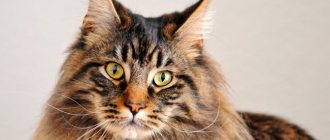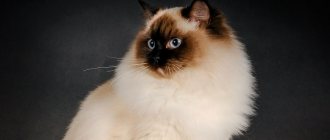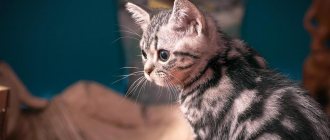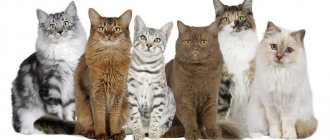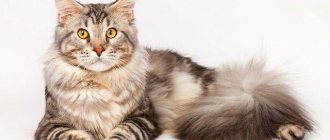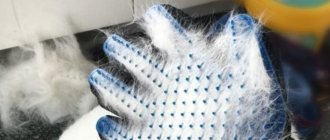Hypoallergenic cats are of interest to those who are prevented from having a four-legged friend by the hypersensitivity of the immune system. Allergies to cats are more common than to other animals. The topic turned out to be very relevant, so Petstory studied the issue, including contacting our veterinarians. In this article, we have prepared a list of hypoallergenic cat breeds for people with allergies and answered popular questions from users.
Causes of allergies
It is a mistake to believe that the reaction is caused by cat hair. In fact, the allergen is most often the Fel D1 protein found in the saliva and skin of cats. Particles of this protein are carried everywhere and, for the most part, settle on the fur - this is where this misconception comes from. There are known breeds of hypoallergenic cats that emit less dangerous protein.
However, for many allergy sufferers, their disease does not prevent them from living in the same house as a cat or even having contact with it. If you adhere to the rules of keeping a pet and correctly use the method of habituation to the “native” allergen (when the patient is regularly administered small doses of the allergen, gradually increasing the amount of the required component), then you can not only get rid of allergy symptoms, but also achieve clinical recovery. After such a course, a person will be able to live normally with his pet, but the reaction to other animals will persist.
Tips for allergic cat owners
As Anthony says, diet and care are useful tools for reducing allergic reactions. “Keeping your cat's coat healthy with fish oil or omega-3 fatty acids reduces the production of allergy-causing protein,” explains the expert.
Another way to get rid of large amounts of protein is to organize regular baths (however, you should not use shampoo often). To remove dandruff, you can use a fine-toothed brush and do it outside to prevent irritating particles from spreading throughout your home.
Currently, scientists are looking for options on how to reduce a protein harmful to humans in the cat’s body, for example, using special medications or food. However, as Anthony says, such methods have not been found, and the easiest way for pet owners is to use existing anti-allergy drugs. There are many antihistamines, the use of which provides more comfortable communication with animals.
Based on materials from www.dailypaws.com
Symptoms of a cat allergy
Signs of a respiratory allergy are:
- nasal congestion and allergic runny nose;
- burning and itching in the nasopharynx;
- shortness of breath, cough, sneezing;
- swelling of the nasopharynx.
Along with the listed symptoms, weakness and even fever can sometimes be observed.
On the skin, an allergy to cats that occurs through direct contact with an animal manifests itself as follows:
- irritation and itching of the skin;
- rashes, redness.
Other symptoms of cat allergies:
- headache;
- weakness;
- swelling of the eyes, profuse lacrimation.
Signs of allergies are varied and appear with varying intensities. Much depends on the characteristics of the human body and the breed of the animal.
Properties of cat allergens
The allergen is smaller in size than pollen, which also affects allergy sufferers and asthmatics. Drying on the cat's fur, it rises into the air and circulates throughout the living space. According to foreign researchers, it can remain indoors for 1.5 years.
The allergen enters the human body when air is inhaled. Fel d has a number of interesting properties:
- Able to stick to objects.
- It hovers in the air for months, even years, and is also transported over considerable distances, ending up in places where a cat’s paw has never gone before.
Veterinarians and allergists have encountered situations where a person develops immunity to their pet. But there is no scientific evidence for such an observation.
Are there any hypoallergenic cat breeds?
There are no breeds that are guaranteed not to cause an allergic reaction (so-called anti-allergenic cat breeds). But there are those with whom this happens much less often. Such cat breeds are conventionally called anti-allergenic. The point is the reduced production of a dangerous protein that settles on the wool. Animals of this type include:
- naked (hairless) cats. Lack of fur is not the main thing. Allergens that accumulate on the skin can be easily removed, for example, by bathing your pet.
- cats without undercoat. The undercoat plays an important role - during the molting period, allergens spread with greater intensity, and cats that do not have a lower layer of hair practically do not shed. True, this feature makes them vulnerable to the cold.
- cats with reduced production of dangerous proteins. Many people do not know that the existence of completely hypoallergenic cat breeds is a myth. The misconception is common because not everyone understands the nature of an allergic reaction. For example, Sphynx cats are often classified as non-allergenic breeds due to their lack of fur, but these cats produce Fel D1 just like any other. Thus, there are simply no cat breeds to which there is no allergy.
This is interesting
Educational facts:
- the older the animal, the more protein it synthesizes;
- pets with light hair are safer than those with dark hair;
- in castrated and sterilized individuals, the amount of the enzyme decreases.
You can ask the breeder for a sample of the animal's saliva or fur. Biological materials are sent to the clinic.
Specialists will conduct a study to determine their compatibility with the blood of an allergic person and provide the result. Based on this, it will become clear whether the pet is suitable or not.
1111
List of breeds to avoid for allergy sufferers
This division is conditional. It all depends on the type of allergy.
Therefore, the most allergenic cat breeds are an individual concept. The following breeds can be noted:
- Persians and exotics. They produce protein in large quantities, and their long hair helps spread it.
- Maine Coon, Norwegian Forest, American Bobtail, Cymric. These owners of thick fur with an undercoat shed heavily, which is why allergens are carried everywhere along with the hairs.
Sphinxes. They secrete protein during regular water procedures, so Sphynx cats can be considered hypoallergenic. However, frequent bathing does not benefit these cats. Their skin begins to peel, and fallen scales become an additional allergen.
Note for allergy sufferers
Before purchasing a little friend in the face of a cat, it is worth studying the following interesting facts.
- As cats age, they secrete more allergic substances. The safest kittens in this regard.
- Castrated males are less dangerous for allergy sufferers than their intact relatives.
- Who is preferable - females or males? For people with allergies, the first option is more suitable, since cats have less “evil” protein in their saliva.
- As a result of observations, it turned out that white cats are safer than black cats.
And one more piece of advice - before buying a future pet, make sure there is no allergic reaction; to do this, play with its mom or dad for a while.
Features of caring for an animal if there is an allergy sufferer in the house
If you follow the rules for caring for animals recommended for people with allergies, the likelihood of unwanted reactions is significantly reduced.
- Bathe cats 1-3 times a week.
- Clean your cat's bed as often as possible, and it's also important to wash and wash toys.
- Wipe hairless pets with wet wipes without alcohol. Hairy cats need to be brushed at least once a week.
- Keep your pet's litter box clean.
- Wash your hands after every contact with your cat.
If it is possible to entrust the care of your cat to a person who does not suffer from allergies, then it is worth doing so. It should also be said about the benefits of sterilization, which leads to reduced production of Fel D1.
Short-haired, allergy-free cats
The shorter the coat, the less Fel d1 protein it contains. Therefore, it is not surprising that most allergen-free pets are short-haired.
Siamese
Legendary ancient breed, known since the 13th century. It is considered classic allergen-free due to its short coat without undercoat. Virtually low-maintenance, sociable, intelligent, friendly animals.
Ocicat
More like a toy than a living cat, the Ocicat is small in size and has short hair that rarely causes an allergic reaction. This pet has large ears, elongated limbs, she is very playful, and will become a wonderful friend to both children and adults.
Colors:
- reddish brown
- chocolate
- cinnamon
- blue
- lilac
- spotted faun
Bengal
This ancient breed has a short coat with no undercoat along with a friendly, playful personality. Bengals get along well with children and are smart and calm. The colors of Bengals are varied:
- spotted
- marble
- black tabby
- silver tabby
Burmanskaya
This kitty is very attached to a person and can follow him around the house. Burmese are sociable, inquisitive, they can watch how you work or relax. They have a strong body and expressive eyes. They tolerate less protein, so they get along well with allergy sufferers.
Colors:
- black
- blue
- lilac
- coffee with milk
- shades of chocolate
Oriental
These allergen-free beauties originated in Thailand, but America is considered the ancestor. It was the Americans who made Orientals recognized by the world. They are distinguished by their intelligence, calm nature, and low likelihood of causing allergies in the owner, because they secrete very little of the mysterious Fel d1 protein. Orientals have a longer tail and an interesting head shape that resembles a triangle. The color is also varied, the palette has more than 300 options, while the eyes are green in all colors except white. These animals have a character trait inherited from their Siamese ancestors - touchiness. Therefore, do not give the Oriental a reason to be offended by you. For this you will be rewarded with friendliness and sociability.
Javanese - Javanese cat
Named after the island of Java, these allergy-free cats have ancestors among the Siamese, Himalayan and Balinese breeds. They have short hair without undercoat in as many as 6 possible colors:
- smoky
- tabby
- shaded
- tortoiseshell
- Torby
- silver
There are also Siamese-type colors and medallion-type colors. Their fur coat is shiny, carrying little allergenic protein, because the peculiarity of the javanese is its slight secretion. They weigh from 2.5 to 5 kg. Physically strong, active animals, amenable to training. They love walks on a leash, but are extremely restless. Make sure to leave a few toys for your pet when you leave him unattended, otherwise you'll end up with your whole house upside down. Be sure to include vitamin B in their diet as they use it up quickly. Javanese dogs are very sociable and love to sleep in bed with their owner.
Lykoi
They are often confused with the Sphinx. Lykoi is an unusual breed that no one specially bred. There was an attempt to breed a new hairless breed, but it ended up with bald patches all over the body. Lykoi resemble ugly ducklings or little devils rather than cats. The word “lykoi” itself is translated from ancient Greek as “werewolf”. Not all people will see them as cute pets. Thanks to their scanty gray-gray coat, devoid of undercoat, the Lykoi is shrouded in the fame of its hypoallergenicity. Lykoi get along well with allergy sufferers. They love their territory, protecting it from other cats and other animals, so you should not have Lykoi where there are already other cats or dogs. But with people they are kind and affectionate.
Colors:
- roan
- black smoke (blue)
Ukrainian Levkoy
This new breed of hairless cats is rapidly gaining popularity. Although still rare, the Levkoy has already received recognition and many awards from breeders around the world. She became the first artificially bred in Ukraine, becoming the only breed of hairless fold cats in the world. The parents of the Ukrainian Levkoy were the Don Sphynx and the Scottish Fold. This breed is devoid of aggression, gets along well with children, and practically does not tolerate allergens.
Devon Rex
Their fur does not scatter throughout the apartment and does not spread the allergen to all corners. This breed's appearance along with its unusually affectionate nature will leave an impression. The Devon Rex is highly trainable, intelligent, and loves people. Outwardly, this kind cat resembles an elf or an alien from another planet. They have eyes of the same color as their coat, except Siamese. Their eyes are sky blue. Very gentle, Devon Rex love to climb higher on their owner, in the neck area, purring with pleasure.
Cornish Rex
Playful, easy-going Cornish people come from England. Their unusual curly coat accumulates little protein, and if you bathe them in a timely manner, then nothing threatens you at all. All secretions are washed off much easier than those of long-haired counterparts, so you can devote yourself to playing with your pet rather than treating allergies. Cornishes look more like a stuffed toy than a real animal. Unfortunately, the history of this breed began with a sad event: in 1936, curly-haired Cornish cats were found in Moravia and... destroyed! People were afraid that they were affected by scab, a dangerous disease transmitted to humans. But that was not the case. Subsequently, breeders recognized the Cornish Rex as a breed, and began breeding them in the 1950s.
Don Sphynx
Originates in Rostov-on-Don in 1987. Bald, affectionate, playful cat, endlessly in love with his owner. Often it falls on exactly those places that hurt the owner. The Don Sphynx has a peculiarity - it sweats all over its body. Walking outside in cold weather is contraindicated for him, and he himself cannot stand the cold.
Peterbald
Intelligent, as befits a true Petersburger, “bald Peter” is a descendant of the Don Sphynx and an oriental cat. Loving his owners, purring, hairless, the Peterbald almost cannot tolerate the insidious squirrel. And if you bathe this friend at least once a week, then there is nothing to remember about allergies. Peterbalds can be either completely hairless or partially covered with hair.
Canadian Sphynx
This breed is considered the leader among hypoallergenic cats. According to reviews from owners, Canadians are the least allergenic, and they are also considered the oldest of all bald dogs. Canadian Sphynxes have an amazing habit of looking into a person's eyes for a long time. Excellent memory allows you to easily train or accustom them to a certain lifestyle.
Colors
- black
- white
- blue
- chocolate
- beige and others
Their large ears tend to accumulate dust, so be sure to clean them at least once a week.
Additional questions about Bengal cats
Are Bengals good pets?
It depends on how you deal with them.
If you have the patience to win their loyalty and affection, they will prove to be the best companions.
However, this takes time and you must be gentle with them throughout.
However, it is a good idea to avoid them if you have little ones in your home.
How much do Bengal cats cost?
Young Bengals turn out to be more expensive than adults.
The average cost of a Bengal cat kitten is about 25,000 rubles, but you can find it cheaper or more expensive.
Location, breeder and quality all influence how much you should pay for these interesting creatures.
It is a good idea to get a Bengal kitten; they are easy to train.
Do Bengal cats have hairballs?
Hairballs are strains of hair that accumulate in a cat's intestines when they are self-grooming.
Cats eventually vomit these pellets and they do no harm.
Nobody likes to watch their cat vomit up clumps of fur.
It's a pretty gross sight that can scare anyone away.
Although getting hair balls is natural, it is still not something that everyone is comfortable with.
This is not a problem you will often encounter with Bengal cats.
Because these "precious cats" do not groom themselves frequently and have short hair, they are less likely to develop hairballs.
However, this does not mean that they are completely immune.
Even Bengals can develop hairballs, but the likelihood of this happening is relatively low.
What is the temperament of Bengal cats?
You may want to rush into purchasing a Bengal cat simply because it is hypoallergenic.
There is much more than you need to know about these bundles of energy.
There may be several of them, and you may sometimes find yourself completely at a loss as to how to deal with them.
Bengalis crave attention and that hunger is never satisfied no matter how hard you try.
They expect you to give them your full attention at all times.
They want to be your priority and love to interact with you most of the day.
Leaving them alone in the house for long hours is a bad idea.
These restless creatures are quite intelligent, observant and curious in everything.
They learn quickly and thus, learning to open drawers, cabinets and boxes is not difficult for them.
When you leave them alone in the house, they perceive it as a betrayal.
They also see this as an opportunity to punish you and satisfy their curiosity at the same time.
So you will return to find your home in ruins with your belongings scattered all over the place.
You can't be strict with them because it brings out their wild side.
Bengals are not cats whose wrath you want to face.
However, they are not always difficult.
If you manage to win them over with your caring and gentle behavior, you will have a loyal and interesting friend for life.
They love to play and that's why they get along with children like a house on fire.
These friendly fur balls also adapt to their new surroundings and family quite easily.
Bengals are bundles of energy.
They think that lying around here is a waste of time.
They love to jump and climb to heights.
If you want an indoor cat, the Bengal is certainly not suitable for you.
Research on Allergy Minimization
Scientists have come to the conclusion that the best medicine for eliminating unpleasant signs of allergies is monomeric allergoid (tablets) under the tongue. An experiment was conducted with the participation of a group of hypersensitive patients with a proposal to undergo a course of therapy with these tablets. The results in the end are impressive. Allergy reactions were not eliminated in only 7 participants. Others felt better. Exacerbations of systemic reactions were no longer observed.
Thus, German scientists created a modern medicine to combat reactions to cat fur, indispensable for asthmatics and allergy sufferers to relieve allergic symptoms.
